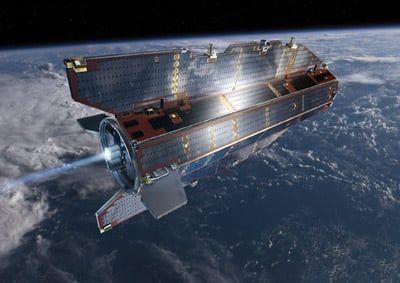This article is more than 1 year old
Upper-atmos ion drive dart sat launch delayed
Plesetsk countdown stopped at T minus 7 seconds
Updated A new European satellite which will fly aerodynamically through the extreme upper reaches of the atmosphere, using ion rocket propulsion to maintain orbital speed, has been held up on the launch pad with just seconds left on the countdown.

The ion ship, buffeted by upper-atmosphere winds.
The dart-shaped GOCE spacecraft (Gravity Field and Steady-State Ocean Circulation Explorer) is being sent up by the European Space Agency (ESA) to measure very small variations in the Earth's gravity. This should permit the planet's geoid to be mapped very precisely, allowing trends in sea level, ice and ocean circulation to be measured more accurately than they now can be.
The satellite was due to be launched today at 14:21 UK time from the Plesetsk cosmodrome in northern Russia, but the countdown was stopped with seven seconds to run.
In order for GOCE to measure the Earth's gravity with the best possible precision, it needs to fly low - just 250km up. There's enough atmosphere at that height to exert significant drag, enough to de-orbit a normal satellite in fairly short order.
But GOCE isn't normal. Unlike other sats it is streamlined, which will reduce the drag it suffers from the ultra-thin fringes of the atmosphere. This wouldn't be enough on its own to keep the spacecraft orbiting, however: it also has a pair of rockets which will burn throughout its 20-month mission, keeping the cruising survey sat up to speed.
An ordinary rocket would require an absurd amount of fuel over such a long period, but GOCE's rockets are electrically-powered T5 ion jobs from Brit defence-lab selloff firm Qinetiq. 'Leccy from the craft's solar cells is used to spit out xenon reaction mass hugely faster than normal exhaust is emitted from regular rockets. This means that GOCE gets a lot more push out of a given amount of fuel, and so it only needs 40kg of xenon for the whole mission.
The downside of ion rockets is that they have poor thrust-to-weight performance, but GOCE only needs a little bit of thrust to counteract the wispy winds found on the edge of space. As for launch, it travels into orbit aboard a Russian Rockot launcher - a converted SS-19 ballistic missile.
There's more on GOCE from the ESA here. ®
Update
It appears that the delay was caused by a technical failure in the Plesetsk launch tower. Dr Matthias Oehm, CEO of Eurockot - the consortium providing the Rockot launcher - told reporters at 1505 that "the door of the tower didn't open, perhaps due to a bolt," and said that more details would be forthcoming once the Russian space forces, in charge at Plesetsk, gave them to him.
There appeared to be no fault with the satellite or the rocket, but the launch window has now passed. ESA officials said the next window will open in approximately 24 hours.
